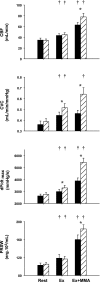Muscle metaboreflex-induced coronary vasoconstriction functionally limits increases in ventricular contractility
- PMID: 20413426
- PMCID: PMC2928591
- DOI: 10.1152/japplphysiol.01243.2009
Muscle metaboreflex-induced coronary vasoconstriction functionally limits increases in ventricular contractility
Abstract
Muscle metaboreflex activation during dynamic exercise induces a substantial increase in cardiac work and oxygen demand via a significant increase in heart rate, ventricular contractility, and afterload. This increase in cardiac work should cause coronary metabolic vasodilation. However, little if any coronary vasodilation is observed due to concomitant sympathetically induced coronary vasoconstriction. The purpose of the present study is to determine whether the restraint of coronary vasodilation functionally limits increases in left ventricular contractility. Using chronically instrumented, conscious dogs (n = 9), we measured mean arterial pressure, cardiac output, and circumflex blood flow and calculated coronary vascular conductance, maximal derivative of ventricular pressure (dp/dt(max)), and preload recruitable stroke work (PRSW) at rest and during mild exercise (2 mph) before and during activation of the muscle metaboreflex. Experiments were repeated after systemic alpha(1)-adrenergic blockade ( approximately 50 microg/kg prazosin). During prazosin administration, we observed significantly greater increases in coronary vascular conductance (0.64 + or - 0.06 vs. 0.46 + or - 0.03 ml x min(-1) x mmHg(-1); P < 0.05), circumflex blood flow (77.9 + or - 6.6 vs. 63.0 + or - 4.5 ml/min; P < 0.05), cardiac output (7.38 + or - 0.52 vs. 6.02 + or - 0.42 l/min; P < 0.05), dP/dt(max) (5,449 + or - 339 vs. 3,888 + or - 243 mmHg/s; P < 0.05), and PRSW (160.1 + or - 10.3 vs. 183.8 + or - 9.2 erg.10(3)/ml; P < 0.05) with metaboreflex activation vs. those seen in control experiments. We conclude that the sympathetic restraint of coronary vasodilation functionally limits further reflex increases in left ventricular contractility.
Figures





Comment in
-
The muscle metaboreflex: reining in the heart?J Appl Physiol (1985). 2010 Aug;109(2):263-4. doi: 10.1152/japplphysiol.00547.2010. Epub 2010 Jun 3. J Appl Physiol (1985). 2010. PMID: 20522736 No abstract available.
References
-
- Ansorge EJ, Augustyniak RA, Perinot RL, Hammond RL, Kim JK, Sala-Mercado JA, Rodriguez J, Rossi NF, O'Leary DS. Altered muscle metaboreflex control of coronary blood flow and ventricular function in heart failure. Am J Physiol Heart Circ Physiol 288: H1381–H1388, 2005 - PubMed
-
- Ansorge EJ, Shah SH, Augustyniak R, Rossi NF, Collins HL, O'Leary DS. Muscle metaboreflex control of coronary blood flow. Am J Physiol Heart Circ Physiol 283: H526–H532, 2002 - PubMed
-
- Asmussen E, Nielsen M. Experiments on nervous factors controlling respiration and circulation during exercise employing blocking of the blood flow. Acta Physiol Scand 60: 103–111, 1964 - PubMed
-
- Augustyniak RA, Ansorge EJ, O'Leary DS. Muscle metaboreflex control of cardiac output and peripheral vasoconstriction exhibit differential latencies. Am J Physiol Heart Circ Physiol 278: H530–H537, 2000 - PubMed
Publication types
MeSH terms
Substances
Grants and funding
LinkOut - more resources
Full Text Sources
Miscellaneous

